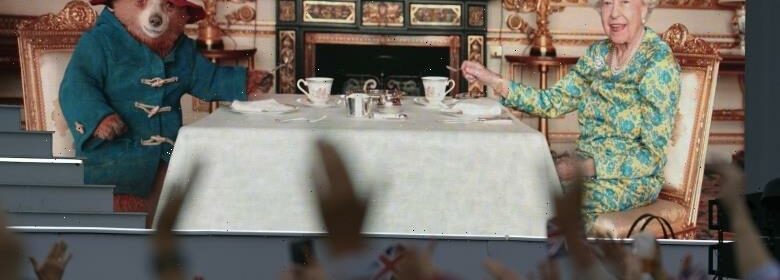No One Played the Queen Better Than Herself (Column)

Queen Elizabeth II was the first British monarch to become a film and television character while she was still on the throne. Raucous historical romps about Henry VIII and Elizabeth I were all very well, but showing what a living king or queen got up to behind closed palace doors? That was another, almost treasonous matter. Even as recently as 1991, when Prunella Scales starred in a BBC film of Alan Bennett’s National Theatre play “A Question Of Attribution,” Bennett said “it still feels quite bold to portray her in the flesh.” And the practice was still contentious enough in 2020 for the UK’s then Culture Secretary, Oliver Dowden, to ask Netflix to put a disclaimer on screen before every episode of “The Crown,” explaining that the show was not actually a documentary.
But like so much else during Elizabeth II’s uniquely long reign, the protocol changed to a degree that would have been unimaginable when she was crowned in 1953. It now feels as if every actress in the country has taken their turn to put on a crown and try out a cut-glass accent. And yet, despite the proliferation of these portrayals, it’s remarkable how respectful they have been.
Before “A Question of Attribution,” Elizabeth II had been caricatured in the likes of “The Naked Gun” (1988) and the “Spitting Image” satirical puppet show, but it was her scandal-prone relations who were treated to serious, long-form dramas: in a BBC film, “The Queen’s Sister” (2005), Lucy Cohu played Princess Margaret as a snooty, hedonistic hot mess.
“The Queen” (2006) changed all that. Directed by Stephen Frears and written by Peter Morgan, this small-scale British film followed the Royal Family as it was rocked by the death of the sovereign’s former daughter-in-law, Princess Diana, in 1997. The film was hardly irreverent, but it allowed Elizabeth II to be a human being, rather than a waxwork. She experienced doubt, confusion and isolation, and a gnawing fear that she might have fallen out of touch with her subjects. For her lead performance, Helen Mirren won an Oscar, a BAFTA, and a Golden Globe.
It’s no wonder that neither she nor Morgan wanted to stop there. They reunited for a West End play, “The Audience” (2013), which imagined Elizabeth II’s weekly meetings with the various Prime Ministers who came and went during her reign. Morgan then created his hit biographical Netflix series, “The Crown” (2016), which made a star of Claire Foy. “In the first two episodes before she becomes Queen,” said Foy, “I could be a lot freer with my emotions, but as the series goes on, she develops an armor to cope. She has to be a sphinx, which must be so hard.”
This is a familiar theme. In “The King’s Speech” (2010), Princess “Lilibet” was a little girl (Freya Wilson), adored by her father (Colin Firth), but already singled out by her grandfather (Michael Gambon) as the only one royal with the wherewithal to rule the country. In “A Royal Night Out” (2015) — a Roman Holiday-style romance loosely based on a real occasion — she was a carefree teenager (Sarah Gadon) who mixed with Londoners incognito and danced the Lindy Hop during London’s VE Celebrations in 1945. Film-makers loved to see Elizabeth as the bright-eyed, independent, energetic youngster who had yet to “develop an armor”.
Then comes the sphinx. The makers of “The Crown” learned from “Doctor Who” and James Bond how much fresh publicity could be had from replacing a lead actor at regular intervals, so Foy was succeeded by Olivia Colman and, this November, by Imelda Staunton. But, Oliver Dowden’s worries notwithstanding, the small-screen Queen remained dignified, reserved and dutiful — unlike some of her supporting characters.
Pablo Larrain’s feverish Princess Diana fantasy, “Spencer” (2021), came as close as any film to presenting Elizabeth (Stella Gonet) as the villain of the piece, but even here her worst crime was her adherence to stuffy tradition. More often, she was given at least some warmth and kindness: in Steven Spielberg’s Roald Dahl adaptation, “The BFG” (2016), she (Penelope Wilton) reduced the Big Friendly Giant to grateful tears. But no one dared stray too far from the Queen’s stoic, restrained, but benign public image.
Amazingly, the boldest portrayals of Elizabeth II were those in which she played herself. The first of these was in the opening ceremony of the 2012 London Olympics when a short film directed by Danny Boyle had Daniel Craig’s James Bond striding into Buckingham Palace, 43 years after she had the title role, sort of, in a Bond movie, “On Her Majesty’s Secret Service” (1969). Boyle’s short film had a jaw-droppingly brilliant visual punchline: the Queen’s stunt double parachuted out of a helicopter toward the Olympic stadium, whereupon the Queen herself emerged in the stands wearing an identical peach dress. Boyle would later be hired as the director of the 25th official Bond movie, only to be replaced soon afterwards — but how could he have topped that?
Still, maybe Elizabeth II herself topped it. For this year’s Platinum Jubilee celebrations, she was in a sketch in which Paddington (voiced by Ben Whishaw) popped in for tea, and her face lit up when she confessed that she always kept a marmalade sandwich in her handbag, just in case. Never before had she appeared so relaxed and playful. Even the most hardline republicans were smitten. However stiff she had been in her many televised Christmas speeches, it turned out that, in her old age, the Queen could really act. No one played the role better than she did.
Source: Read Full Article